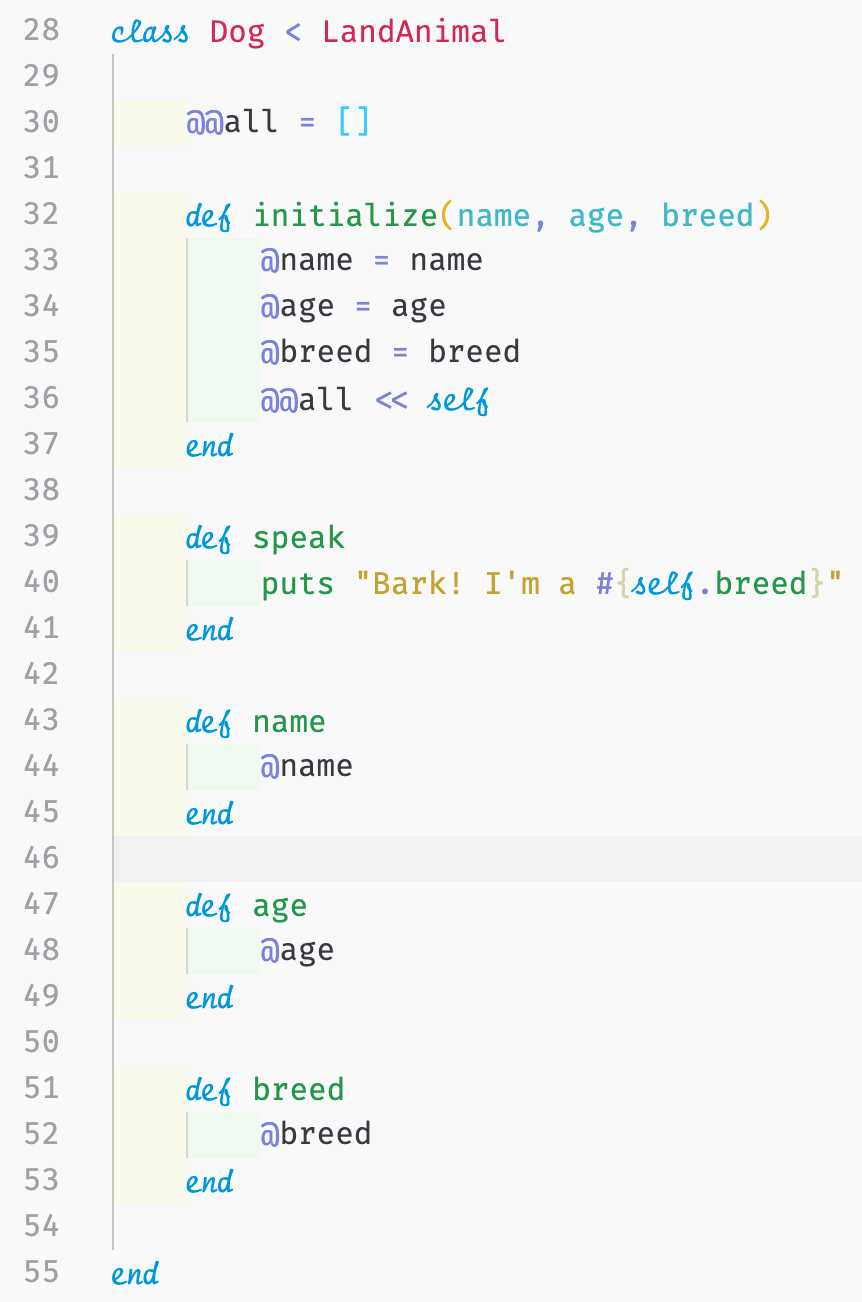#2b OOP Series: Attributes (Getter and Setter Methods)
In this series, I will go over the principles and foundations of object-oriented programming and some principles on databases.
In this series, I will go over the principles and foundations of object-oriented programming and some principles on databases. I will be using Ruby because I feel comfortable in the language; however, these concepts with some minor changes in syntax can be translated to other object-oriented programming languages, like Java, Node.js, etc.
Welcome back!
This week, I wanted to talk about the attr method that is used in classes. Next week, I plan on writing about the associations which is something you should know when working with relational databases, like PostgreSQL.
First, let's do a recap of what we covered in the last couple of weeks and look at the code we wrote last week.
As you may recall, we had a Dog class that initialized with the attributes of name, age, and breed. We also had a similar initialize method with the attributes of name, age, and height. You may have noticed that to to call on those attributes we needed to create instance methods which returns the value of that attribute called inside.
Let's examine the Dog class' name method:
class Dog ... def name @name end ... end dog1 = Dog.new("Rover", 3, "Poodle") #=> #<Dog:0x00007fb8dba87000 @age=3, @breed="Poodle", @name="Rover"> dog1.name #=> "Rover"
Without the name method to return the name attribute this is the error we would receive:
NoMethodError: undefined method `name' for #<Dog:0x00007fb0d1cc3830 @name="Rover", @age=3, @breed="Poodle"> from (pry):1:in `<main>'
Why
This is part of the funny behavior you'll notice as you get more involved with ActiveRecord (covered a little later in this series).
When we call [dog1.name](http://dog1.name) we're not calling on the name attribute, but instead the name method (or what will be referred to as the name "reader" method).
A Quick Note on Reader and Writer Methods
Reader Methods (Getter Methods)
It says it in the name, reader methods (also known as getter methods) are methods that allow you to access information in a read-only format. For instance, making a mix on a CD-R, you can only access the music on there but you can't rewrite the information. (Hope that doesn't date me too much, I'm an "old" 26 year old - I hope I'm still hip.) So when we try to rewrite or overwrite the information on a reader method, like name, we receive this error:
NoMethodError: undefined method `name=' for #<Dog:0x00007fab5443c798 @name="Rover", @age=3, @breed="Poodle"> Did you mean? name from (pry):1:in `<main>'
The keyword in this error message is the 'name=' part. It's giving us the answer. It's saying it doesn't recognize the 'name=' method, so we should write one.
Writer Methods (Setter Methods)
Similar to above, writer methods (also known as setter methods) are methods that allow you to rewrite or overwrite information. For instance, adding and/or replacing phone numbers on speed dial on your landline. (I'm still young and hip.) So when you rewrite the information on an attribute you simple set the attribute equal to the new value.
Let's try it out:
class Dog ... def name @name end def name= (new_name) @name = new_name end ... end dog1 = Dog.new("Rover", 3, "Poodle") #=> #<Dog:0x00007fd44d5bb1b0 @age=3, @breed="Poodle", @name="Rover"> dog1.name #=> "Rover" dog1.name = "Bean" #=> "Bean" dog1 #=> #<Dog:0x00007fd44d5bb1b0 @age=3, @breed="Poodle", @name="Bean">
Here, we have successfully changed our dog's name from "Rover" to "Bean."
The attr method
When you're first starting out, this may perhaps seem like a lot to remember and typing, creating reader and writer methods. However, your life is about become a little easier.... I would like to introduce the attr method to you.
There are three attr methods to remember: attr_accessor, attr_reader, and attr_writer. They'll replace the getter (reader) and setter (writer) instance methods.
attr_accessor
The attr_accesor method allows you to read and write. A general rule of thumb that I stick to is when in doubt, you this one. Unless it a method that should be read only.
attr_reader
The attr_reader method creates the getter instance method.
attr_writer
The attr_writer method creates the setter instance method.
Refactoring
Before
class Dog < LandAnimal @@all = [] def initialize(name, age, breed) @name = name @age = age @breed = breed @@all << self end def speak puts "Bark! I'm a #{self.breed}" end def name @name end def name= (new_name) @name = new_name end def age @age end def breed @breed end end
After
Let's refactor our Dog class and use our attr methods:
class Dog < LandAnimal attr_accessor :name attr_reader :breed, :age @@all = [] def initialize(name, age, breed) @name = name @age = age @breed = breed @@all << self end def speak puts "Bark! I'm a #{self.breed}" end end
That's right! It's that easy and there's no gem to download. It's simply built into Ruby already. To show off a writer method, we could have added a new_toy attribute and it could change every time the dog receives a new toy.
Conclusion
I hope this blog post helped explain setter (writer) and getter (reader) methods. No matter what language you're currently learning, these concepts can still be found. They may just have different syntax.
As mentioned above, next week I'll go over model associations.
